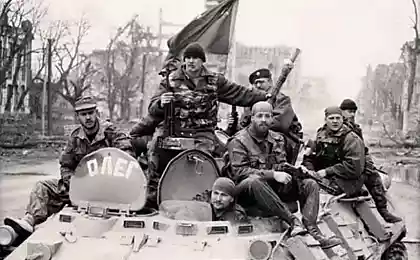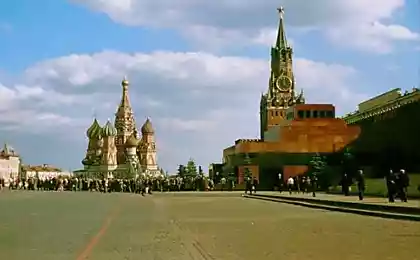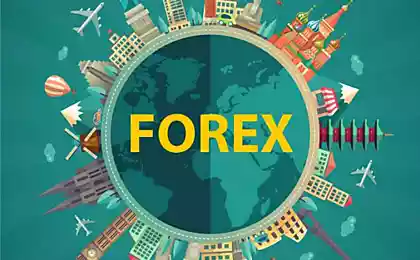988
Trade in the USSR
like never seen such sdes ph, I was reminded detstve small. Fot neiibicheskoe count, in the end I will say kada end. Kamenty leave the author, because of the senses.
... Paehali remember
1959. Grocery department. Typical. If I do not change the vision, products on the counter is not very rich, to put it euphemistically. And if we talk directly and without embellishment, the counter completely empty. The truth must be admitted that behind seller something hanging. I, frankly, did not understand - what it is. Tolley decomposed carcasses, or something wrapped in waxed paper. Well, we assume that this meat.
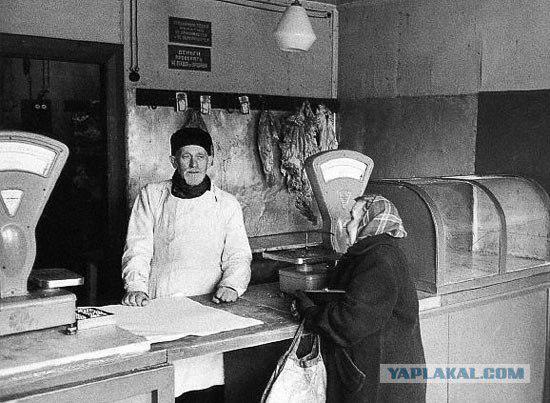
1964 Moscow. GUM. Gumovsky cream zavsegda popular. And in the 64th ...
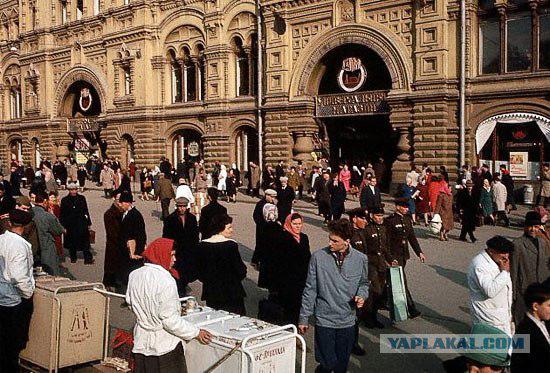
and in 1987.
But as they say, not a single ice cream ...
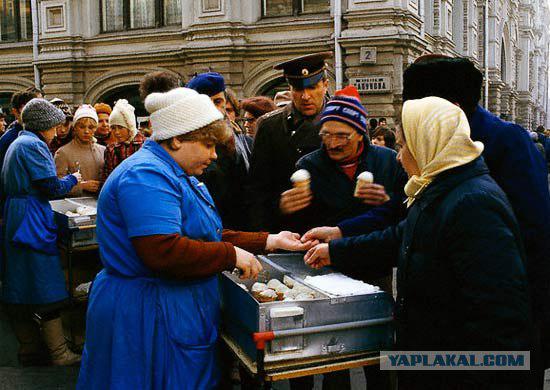
1965. In Soviet times, to the design approach is very simple. There was a heap of silly names. Shops in all cities called simple, but clear: "Bread", "Milk", "meat", "fish". In this case - "Food store."

But the toy department. Shop, therefore, department store. All the same the year 1965. I remember in 1987 a friend of my girlfriend - a saleswoman in a store "House of Books" at the Kalinin told that she is uncomfortable every time when foreigners stunned froze, watching as she counts the cost of buying in the accounts. But it was 1987, but it was in 1965, no one scores did not cause surprise. In the background is seen the department of sports games. There are different chess, checkers, dominoes - a typical set. Well, bingo and games with dice and tokens (some are very interesting). In the foreground - a children's rocking horse. I was not so.
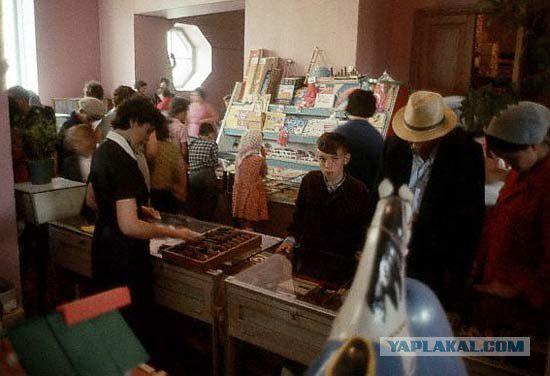
All the same in 1965. Commercial apples on the street. Please pay attention to packaging - paper bag (the woman in the foreground puts it apples). Such packages from third-papers were all the way to one of the most common view of the Soviet package.
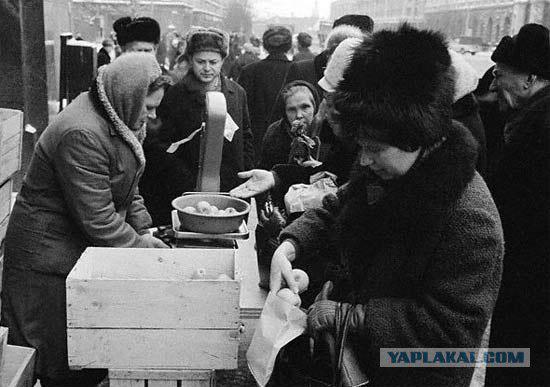
1966. Supermarket - Supermarket self-service. At the outlet shopping is not sitting cashier with cash register and the clerk with an abacus. Check strung on a special awl (standing in front of an abacus). On the shelves - a typical set: something in packs (tea? Tobacco? Dry pudding?), Then the brandy and generally some bottles, and on the horizon - the traditional Soviet pyramid of canned fish.

1968. The progress is evident. Instead account - cash registers. There are shopping basket - by the way, it is so cute design. In the left bottom row visible hand of the buyer with a carton of milk - such characteristic prisms. In Moscow, these were of two types: red (25 cents) and blue (16 cents). Different fat content. On the shelves, as far as can be discerned - the traditional cans and bottles of sunflower oil (like). Interestingly, the output two sellers: buy and cashier checks (her head out from behind the right shoulder aunt seller with typical Soviet Seller expression).

1972. Take a closer look, there was on the shelves. Sprat (by the way, they later became a deficit), a bottle of sunflower oil, some more canned fish, right - things like cans of condensed milk. Cupping is very, very much. But items - very little. Multiple views of canned fish, two types of milk, butter, leaven wort, what else?
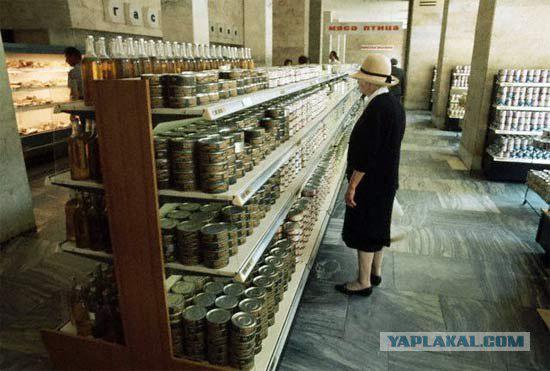
1966. Something did not understand what it was there looking at buyers.
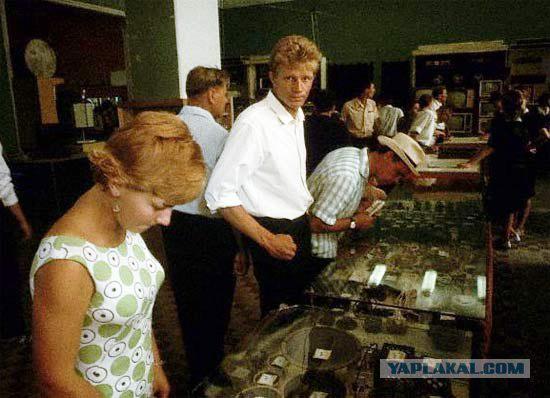
1967. This is not a Leninist room. This department of the House to the book on the Kalinin. Today, these shopping areas packed with all sorts of books (on history, philosophy), and then - portraits of Lenin and the Politburo.
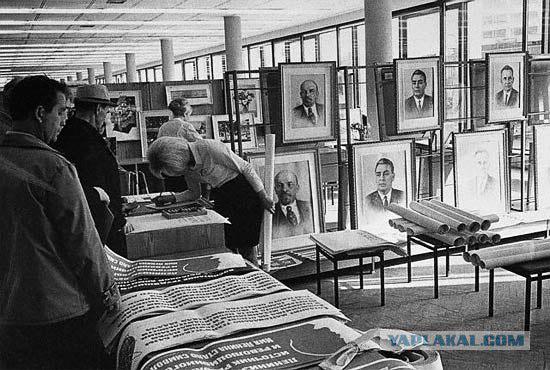
1967. For children - plastic astronauts. Very affordable - just 70 cents apiece.

1974. A typical grocery store. Again: a pyramid of canned fish, a bottle of champagne, the battery green peas «Globus» (Hungarian seem Bulgarian or - I do not remember something already). Half-liter cans of something like grated beets and horseradish with beets, packs of cigarettes, a bottle of Armenian cognac. On the right (with the weights) empty flasks for sale juice. The juice was usually: tomato (10 cents a glass), plum (12 or 15, I do not remember), apple (same), grape (the same way). Sometimes in Moscow I visited tangerine and orange (50 cents - a wildly expensive). Near flasks certainly was a saucer of salt, which could stomach (taken from a glass of water) to add to your glass of tomato juice and stir. I zavsegda liked a drink tomato juice.
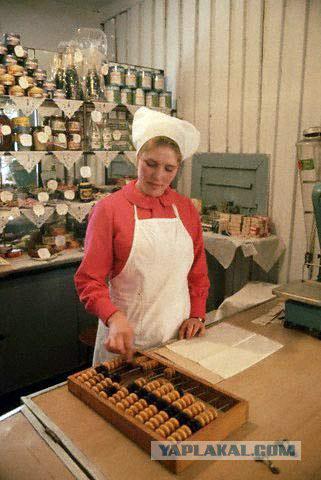
1975. City of Peace. On the left, as far as can be judged, deposits bagels, cakes and cookies - all in plastic bags. Right eternal canned fish and - bottom - 3-liter jars of canned cucumbers.
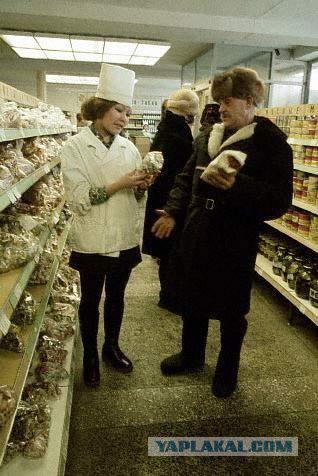
1975. City of Peace. General view of the interior of the shop.

1979. Moscow. People are waiting for the end of the lunch break at the store. Showcase decorated with a typical icon of the shop "Vegetables, fruits." The showcase itself - banks with jam. And, it seems, the same species.

1980. Novosibirsk. General view of the supermarket. In the foreground a battery of bottles of milk. Further, the metal mesh containers something like deposits of canned fish. In the background Grocery - bags of flour and noodles. The total number enliven dull landscape plastic icons departments. We must give there the designers - icons are quite clear. Not that the icon of the program Microsoft Word.

1980. Novosibirsk. Manufactured goods. The furniture in the form of sofas and cabinets. Further sports department (checkers, inflatable lifebuoys, billiards, dumbbells and various other little thing). More further, under the stairs - TVs. In the background - partially empty shelves.
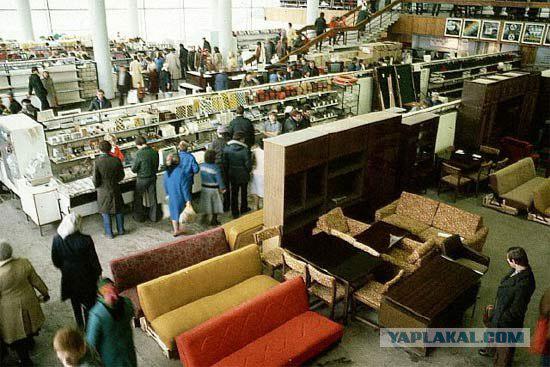
Kind of the same store from the consumer electronics department. In the sports department distinguishable life jackets and hockey helmets. In general - it was probably one of the best shops in Novosibirsk (I think so).
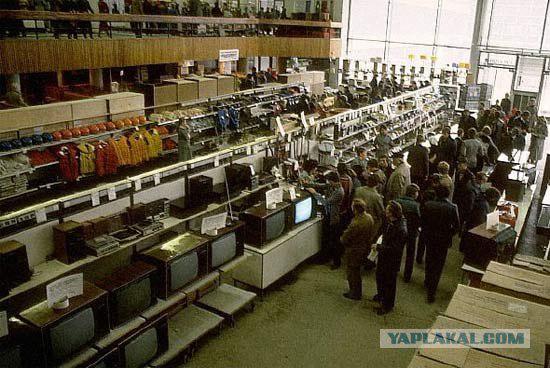
1980. Vegetable Division. Queue tensely watching the clerk. In the foreground - green cucumbers, which appeared in stores in early spring (and then disappear).
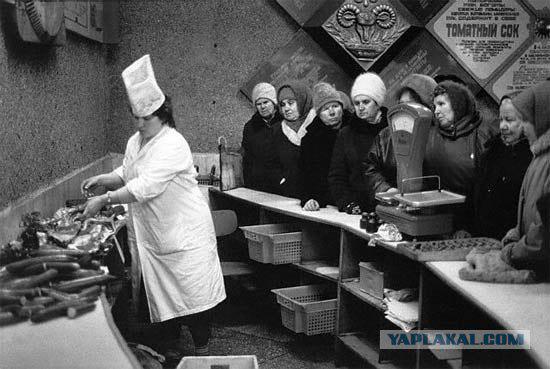
1980. Sausage. Krakow, should be.
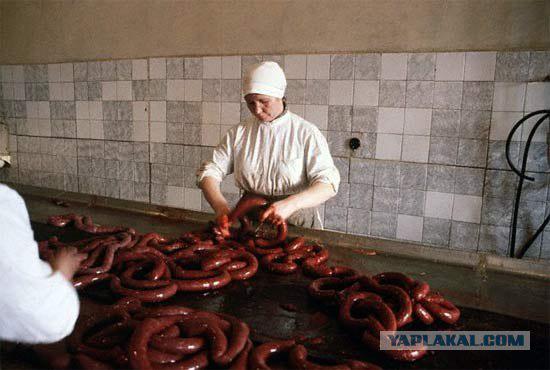
1981. Moscow. The typical design of the shop. "Milk." Right Woman rolls wildly scarce imported stroller "little windows».
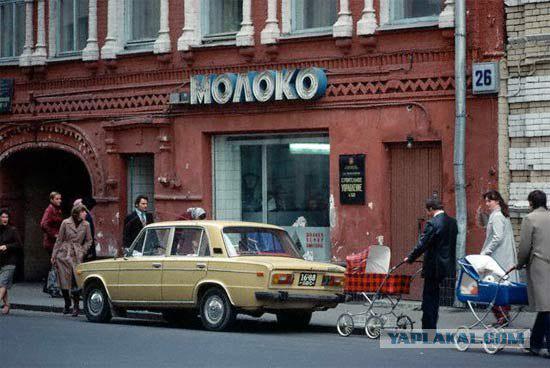
1982. In the market of the Soviet people resting soul.
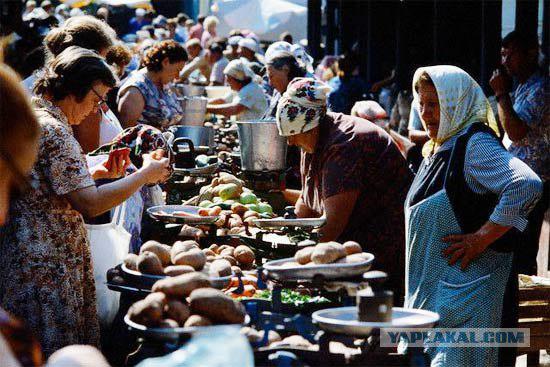
1983. The line of footwear. Not otherwise imported boots "thrown out."
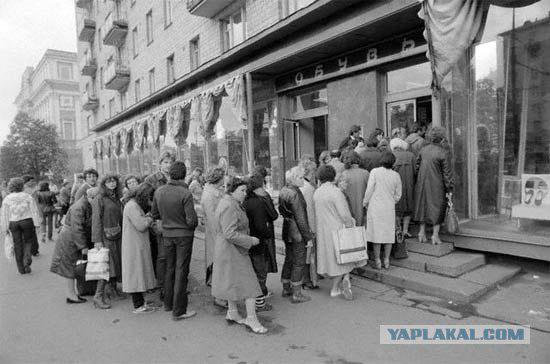
1987. Queue for something.

Saleswoman kvass. For kvass people went to aluminum cans or three-liter jar.
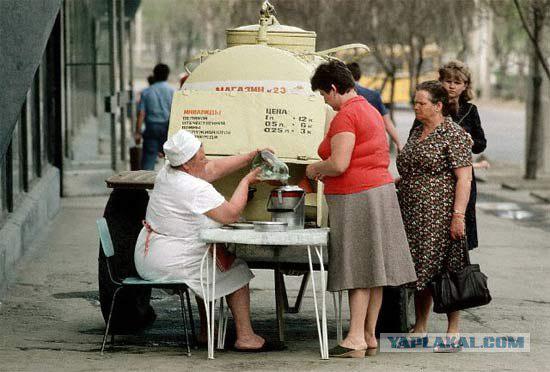
1987. Electric.
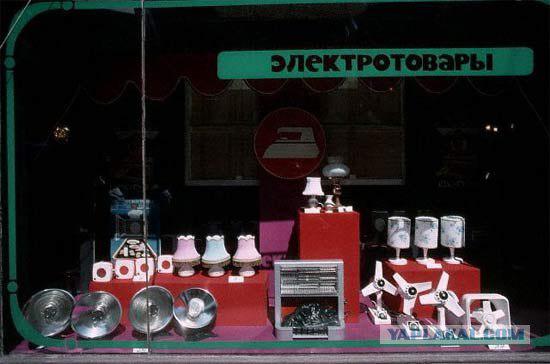
No comments.
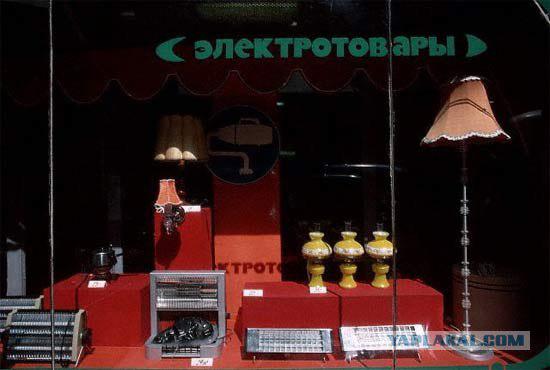
Soviet underwear, as it is. Without all sorts of bourgeois colorful packages.

Osoboduhovnym men fashion shoes is not necessary. But the women in this picture which is not very fun look.

The same shoes ... But where to go? The other is not present.
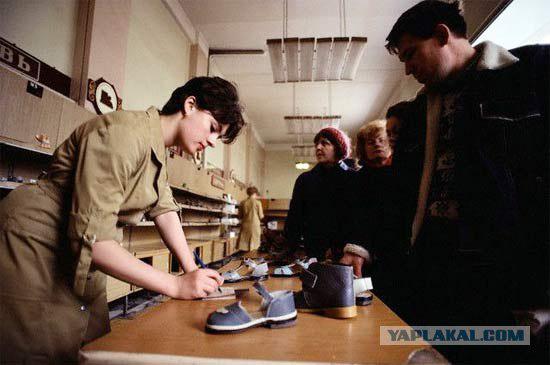
Almost a sacred place - the meat department. "Communism - is when every Soviet citizen would have a butcher friend" (out of a movie).
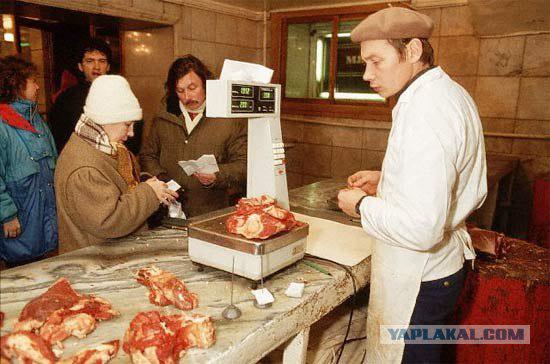
"Pork" - 1 ruble 90 kopeks per kilogram. Grandparents do not believe their eyes. "Butcher, bitch, all the meat sold to the left!»
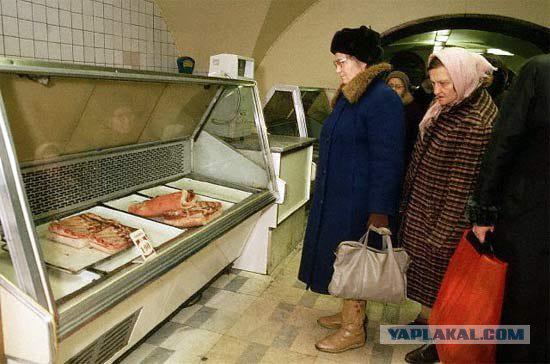
Soviet queue. What people look busy - "Will there be enough?".
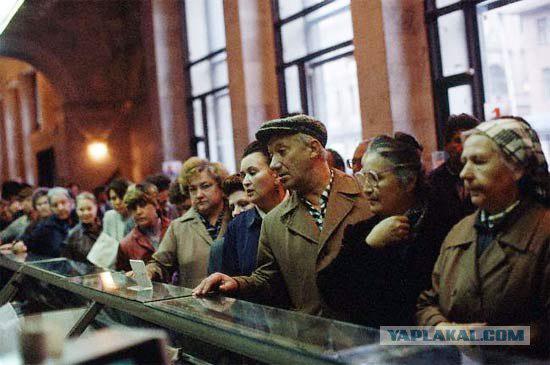
"Who brought the meat. You'll see, it must be brought. "

"Eating meat!" Local fight for a better piece.
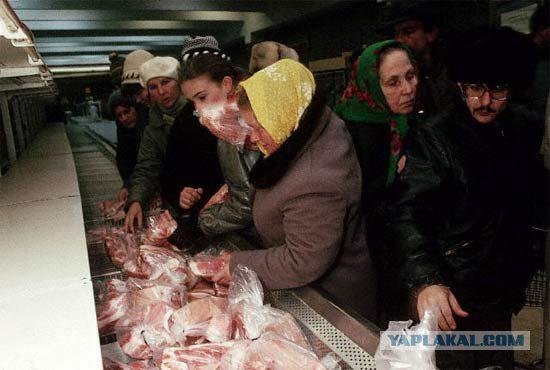
A phallic symbol. Just look with reverence aunt keeps the subject in order to understand that the Soviet Union sausage was much more than just food.
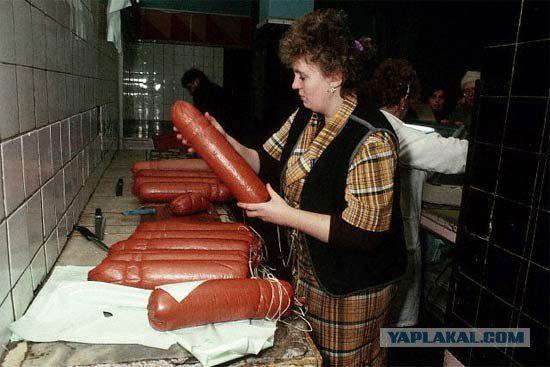
It should be cut into larger pieces of sausage, which is then instantly swept away from the counter.
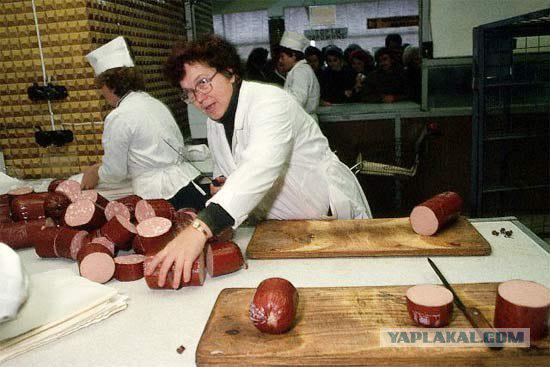
Frozen hake - it's certainly not a sausage, but there are also possible. Although, of course, it all looks not very aesthetically pleasing.
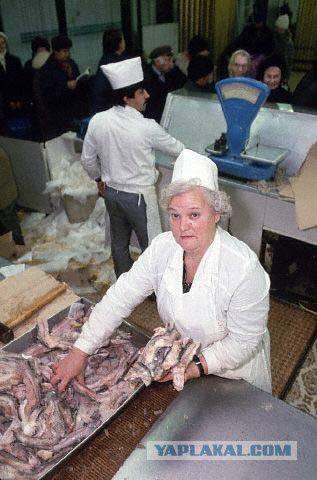
Not a single sausage ... In the Soviet color television Soviet man had put almost salary for 4-6 months ("Electronics" is 755 rubles).
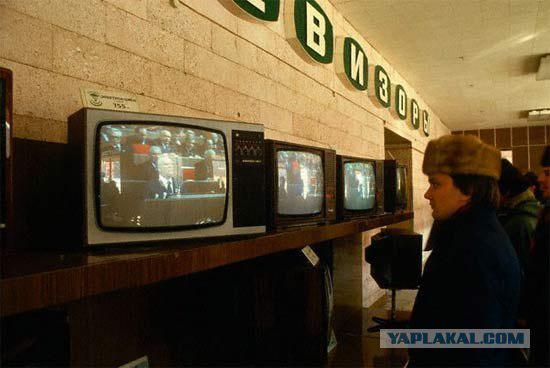
Vegetable Division. In the foreground a cart with some rot. And it was assumed that this rot someone can buy.

Indestructible Soviet antagonism between buyers and sellers of the Soviet. In the eyes of the men read that he would be strangled with pleasure saleswoman. But a saleswoman throttle is not so simple - Soviet trade tempered people. Soviet saleswoman knew how to deal with customers. More than once I have seen a flurry of disturbances and attempted rebellion in line, but the result has always been immutable - victory remained here for so-aunts saleswomen.
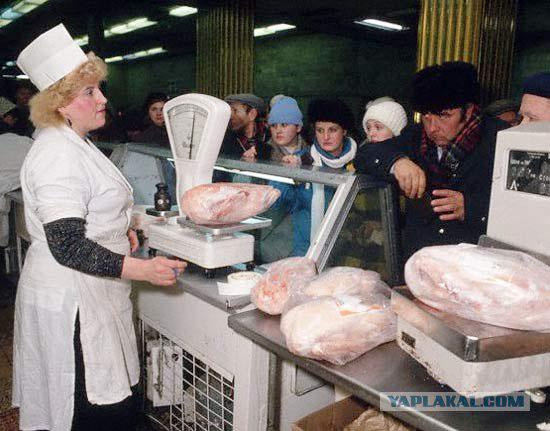
One feature was the presence Scoop sophisticated system of privileges (any veterans out there, "prisoners of concentration camps," etc.). Different beneficiaries with red crusts in the Soviet lines hated almost as much as the sellers. There's a mug with a hat - no to "all" to take the put a duck, it is a red crust vanities - apparently claims to two ducks.
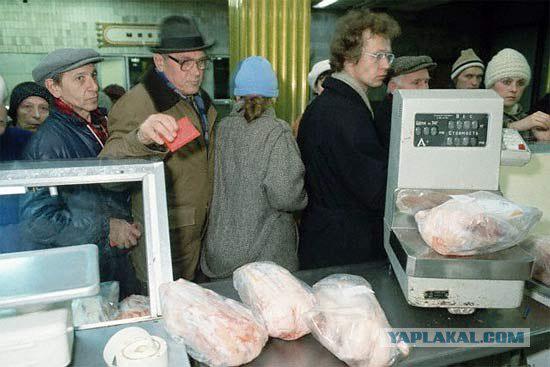
This photo is interesting not so much selling Heck, how many packing. In this tough brown paper wrapped in the Soviet Union, almost all purchases. In general, most gloomy, it was in the Soviet trade - is the packaging, which, in fact, was not.
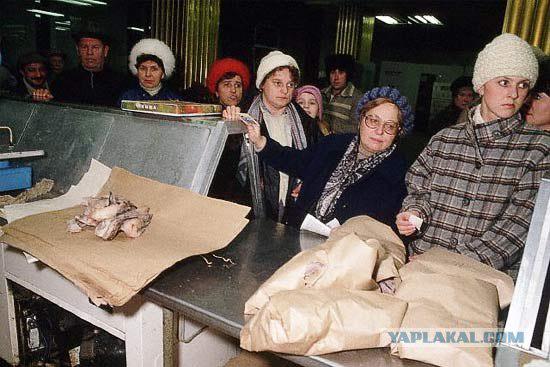
More kind of place.

And yet ...

And yet ...
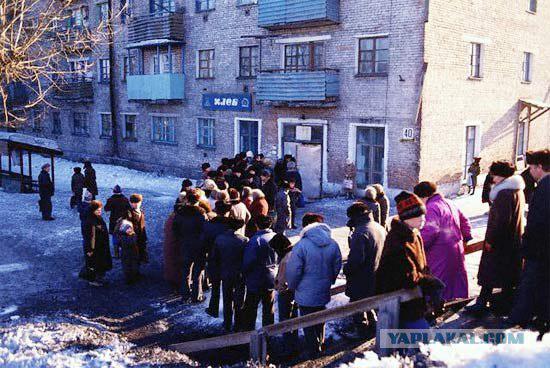
Suffering. No comments.
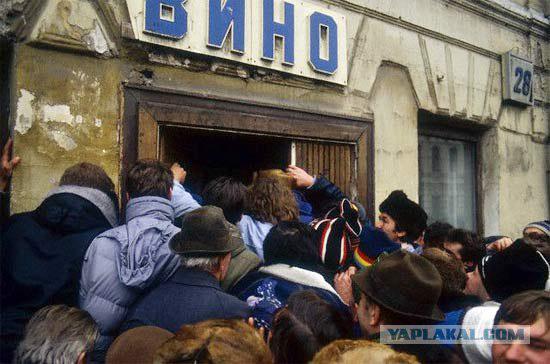
Who did not, that was late. Now the spell will not help.)))))) Here smiyalso
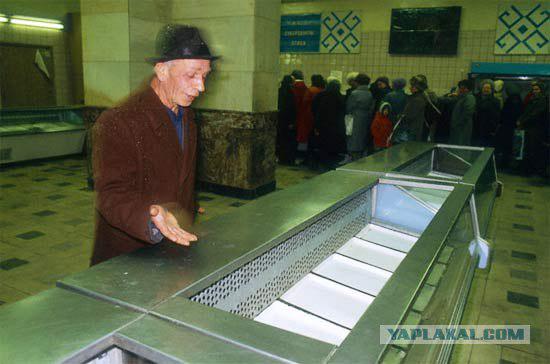
Queue in the dairy department

"The work we have a simple ...»
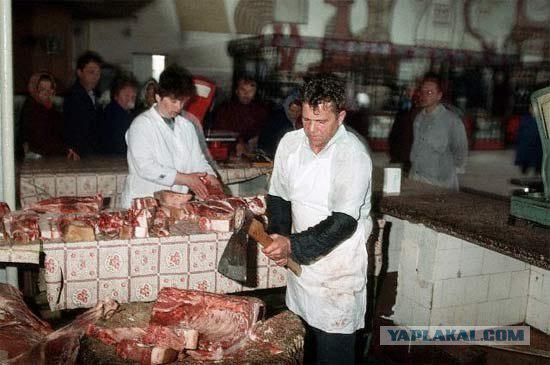
The queue to the wine department

1991. Well, this is the apotheosis. Finito ...

And that's another part, the line of people who wanted at least an hour to escape from Scoop. And there is no spirituality.
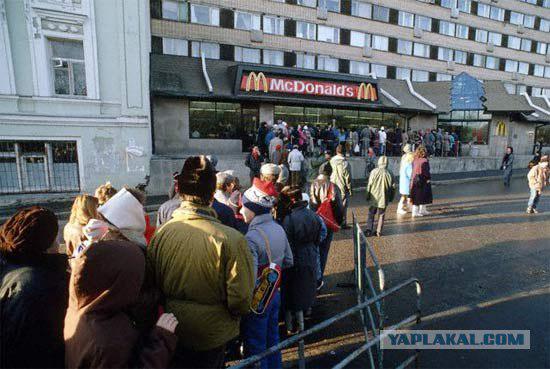
germanych.livejournal.com FSE. Kanets

Source:
... Paehali remember
1959. Grocery department. Typical. If I do not change the vision, products on the counter is not very rich, to put it euphemistically. And if we talk directly and without embellishment, the counter completely empty. The truth must be admitted that behind seller something hanging. I, frankly, did not understand - what it is. Tolley decomposed carcasses, or something wrapped in waxed paper. Well, we assume that this meat.

1964 Moscow. GUM. Gumovsky cream zavsegda popular. And in the 64th ...

and in 1987.
But as they say, not a single ice cream ...

1965. In Soviet times, to the design approach is very simple. There was a heap of silly names. Shops in all cities called simple, but clear: "Bread", "Milk", "meat", "fish". In this case - "Food store."

But the toy department. Shop, therefore, department store. All the same the year 1965. I remember in 1987 a friend of my girlfriend - a saleswoman in a store "House of Books" at the Kalinin told that she is uncomfortable every time when foreigners stunned froze, watching as she counts the cost of buying in the accounts. But it was 1987, but it was in 1965, no one scores did not cause surprise. In the background is seen the department of sports games. There are different chess, checkers, dominoes - a typical set. Well, bingo and games with dice and tokens (some are very interesting). In the foreground - a children's rocking horse. I was not so.

All the same in 1965. Commercial apples on the street. Please pay attention to packaging - paper bag (the woman in the foreground puts it apples). Such packages from third-papers were all the way to one of the most common view of the Soviet package.

1966. Supermarket - Supermarket self-service. At the outlet shopping is not sitting cashier with cash register and the clerk with an abacus. Check strung on a special awl (standing in front of an abacus). On the shelves - a typical set: something in packs (tea? Tobacco? Dry pudding?), Then the brandy and generally some bottles, and on the horizon - the traditional Soviet pyramid of canned fish.

1968. The progress is evident. Instead account - cash registers. There are shopping basket - by the way, it is so cute design. In the left bottom row visible hand of the buyer with a carton of milk - such characteristic prisms. In Moscow, these were of two types: red (25 cents) and blue (16 cents). Different fat content. On the shelves, as far as can be discerned - the traditional cans and bottles of sunflower oil (like). Interestingly, the output two sellers: buy and cashier checks (her head out from behind the right shoulder aunt seller with typical Soviet Seller expression).

1972. Take a closer look, there was on the shelves. Sprat (by the way, they later became a deficit), a bottle of sunflower oil, some more canned fish, right - things like cans of condensed milk. Cupping is very, very much. But items - very little. Multiple views of canned fish, two types of milk, butter, leaven wort, what else?

1966. Something did not understand what it was there looking at buyers.

1967. This is not a Leninist room. This department of the House to the book on the Kalinin. Today, these shopping areas packed with all sorts of books (on history, philosophy), and then - portraits of Lenin and the Politburo.

1967. For children - plastic astronauts. Very affordable - just 70 cents apiece.

1974. A typical grocery store. Again: a pyramid of canned fish, a bottle of champagne, the battery green peas «Globus» (Hungarian seem Bulgarian or - I do not remember something already). Half-liter cans of something like grated beets and horseradish with beets, packs of cigarettes, a bottle of Armenian cognac. On the right (with the weights) empty flasks for sale juice. The juice was usually: tomato (10 cents a glass), plum (12 or 15, I do not remember), apple (same), grape (the same way). Sometimes in Moscow I visited tangerine and orange (50 cents - a wildly expensive). Near flasks certainly was a saucer of salt, which could stomach (taken from a glass of water) to add to your glass of tomato juice and stir. I zavsegda liked a drink tomato juice.

1975. City of Peace. On the left, as far as can be judged, deposits bagels, cakes and cookies - all in plastic bags. Right eternal canned fish and - bottom - 3-liter jars of canned cucumbers.

1975. City of Peace. General view of the interior of the shop.

1979. Moscow. People are waiting for the end of the lunch break at the store. Showcase decorated with a typical icon of the shop "Vegetables, fruits." The showcase itself - banks with jam. And, it seems, the same species.

1980. Novosibirsk. General view of the supermarket. In the foreground a battery of bottles of milk. Further, the metal mesh containers something like deposits of canned fish. In the background Grocery - bags of flour and noodles. The total number enliven dull landscape plastic icons departments. We must give there the designers - icons are quite clear. Not that the icon of the program Microsoft Word.

1980. Novosibirsk. Manufactured goods. The furniture in the form of sofas and cabinets. Further sports department (checkers, inflatable lifebuoys, billiards, dumbbells and various other little thing). More further, under the stairs - TVs. In the background - partially empty shelves.

Kind of the same store from the consumer electronics department. In the sports department distinguishable life jackets and hockey helmets. In general - it was probably one of the best shops in Novosibirsk (I think so).

1980. Vegetable Division. Queue tensely watching the clerk. In the foreground - green cucumbers, which appeared in stores in early spring (and then disappear).

1980. Sausage. Krakow, should be.

1981. Moscow. The typical design of the shop. "Milk." Right Woman rolls wildly scarce imported stroller "little windows».

1982. In the market of the Soviet people resting soul.

1983. The line of footwear. Not otherwise imported boots "thrown out."

1987. Queue for something.

Saleswoman kvass. For kvass people went to aluminum cans or three-liter jar.

1987. Electric.

No comments.

Soviet underwear, as it is. Without all sorts of bourgeois colorful packages.

Osoboduhovnym men fashion shoes is not necessary. But the women in this picture which is not very fun look.

The same shoes ... But where to go? The other is not present.

Almost a sacred place - the meat department. "Communism - is when every Soviet citizen would have a butcher friend" (out of a movie).

"Pork" - 1 ruble 90 kopeks per kilogram. Grandparents do not believe their eyes. "Butcher, bitch, all the meat sold to the left!»

Soviet queue. What people look busy - "Will there be enough?".

"Who brought the meat. You'll see, it must be brought. "

"Eating meat!" Local fight for a better piece.

A phallic symbol. Just look with reverence aunt keeps the subject in order to understand that the Soviet Union sausage was much more than just food.

It should be cut into larger pieces of sausage, which is then instantly swept away from the counter.

Frozen hake - it's certainly not a sausage, but there are also possible. Although, of course, it all looks not very aesthetically pleasing.

Not a single sausage ... In the Soviet color television Soviet man had put almost salary for 4-6 months ("Electronics" is 755 rubles).

Vegetable Division. In the foreground a cart with some rot. And it was assumed that this rot someone can buy.

Indestructible Soviet antagonism between buyers and sellers of the Soviet. In the eyes of the men read that he would be strangled with pleasure saleswoman. But a saleswoman throttle is not so simple - Soviet trade tempered people. Soviet saleswoman knew how to deal with customers. More than once I have seen a flurry of disturbances and attempted rebellion in line, but the result has always been immutable - victory remained here for so-aunts saleswomen.

One feature was the presence Scoop sophisticated system of privileges (any veterans out there, "prisoners of concentration camps," etc.). Different beneficiaries with red crusts in the Soviet lines hated almost as much as the sellers. There's a mug with a hat - no to "all" to take the put a duck, it is a red crust vanities - apparently claims to two ducks.

This photo is interesting not so much selling Heck, how many packing. In this tough brown paper wrapped in the Soviet Union, almost all purchases. In general, most gloomy, it was in the Soviet trade - is the packaging, which, in fact, was not.

More kind of place.

And yet ...

And yet ...

Suffering. No comments.

Who did not, that was late. Now the spell will not help.)))))) Here smiyalso

Queue in the dairy department

"The work we have a simple ...»

The queue to the wine department

1991. Well, this is the apotheosis. Finito ...

And that's another part, the line of people who wanted at least an hour to escape from Scoop. And there is no spirituality.

germanych.livejournal.com FSE. Kanets

Source:

















